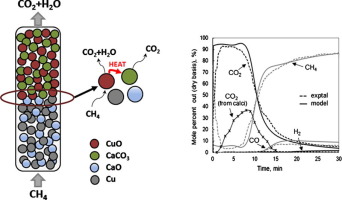当前位置:
X-MOL 学术
›
Chem. Eng. Sci.
›
论文详情
Our official English website, www.x-mol.net, welcomes your feedback! (Note: you will need to create a separate account there.)
Experimental testing and model validation of the calcination of calcium carbonate by the reduction of copper oxide with CH4
Chemical Engineering Science ( IF 4.7 ) Pub Date : 2019-01-01 , DOI: 10.1016/j.ces.2018.09.001 José Ramón Fernández , Juan Carlos Abanades
Chemical Engineering Science ( IF 4.7 ) Pub Date : 2019-01-01 , DOI: 10.1016/j.ces.2018.09.001 José Ramón Fernández , Juan Carlos Abanades

|
Abstract The reduction reaction of copper oxide with CH4 is highly exothermic and can be arranged to generate sufficient heat to in-situ calcine calcium carbonate and produce a highly concentrated stream of CO2. This concept is tested at TRL4 in a packed-bed reactor operated close to adiabatic conditions. The impact of the initial solids temperature and the inlet flowrate of the gases is evaluated. A 50/50 (vol.%) mixture of methane and hydrogen (i.e., a possible composition of the PSA-off gas generated in a reforming process) has also been used as reducing gas. The presence of H2 reduces the CuO/CaCO3 proportion required in the bed and promotes the calcination at temperatures lower than 870 °C. The experimental measurements are well predicted by a one-dimensional fixed-bed reactor model, in which the steam methane reforming, water–gas-shift, carbon deposition and carbon gasification reactions are also considered. Different characterization techniques (i.e., SEM, XRD, N2 adsorption, TPR) demonstrate that both commercial CuO- and CaO-based materials show good stability after successive cyclic experiments.
中文翻译:

CH4还原氧化铜煅烧碳酸钙的实验测试和模型验证
摘要 氧化铜与 CH4 的还原反应是高度放热的,可以安排产生足够的热量来原位煅烧碳酸钙并产生高浓度的 CO2 流。这个概念在接近绝热条件下运行的填充床反应器中的 TRL4 进行了测试。评估初始固体温度和气体入口流速的影响。甲烷和氢气的 50/50 (vol.%) 混合物(即重整过程中产生的 PSA 废气的可能组成)也已用作还原气体。H2 的存在降低了床中所需的 CuO/CaCO3 比例,并促进了在低于 870 °C 的温度下的煅烧。一维固定床反应器模型很好地预测了实验测量结果,其中蒸汽甲烷重整、水煤气变换、还考虑了碳沉积和碳气化反应。不同的表征技术(即 SEM、XRD、N2 吸附、TPR)表明商业 CuO 和 CaO 基材料在连续循环实验后都表现出良好的稳定性。
更新日期:2019-01-01
中文翻译:

CH4还原氧化铜煅烧碳酸钙的实验测试和模型验证
摘要 氧化铜与 CH4 的还原反应是高度放热的,可以安排产生足够的热量来原位煅烧碳酸钙并产生高浓度的 CO2 流。这个概念在接近绝热条件下运行的填充床反应器中的 TRL4 进行了测试。评估初始固体温度和气体入口流速的影响。甲烷和氢气的 50/50 (vol.%) 混合物(即重整过程中产生的 PSA 废气的可能组成)也已用作还原气体。H2 的存在降低了床中所需的 CuO/CaCO3 比例,并促进了在低于 870 °C 的温度下的煅烧。一维固定床反应器模型很好地预测了实验测量结果,其中蒸汽甲烷重整、水煤气变换、还考虑了碳沉积和碳气化反应。不同的表征技术(即 SEM、XRD、N2 吸附、TPR)表明商业 CuO 和 CaO 基材料在连续循环实验后都表现出良好的稳定性。


























 京公网安备 11010802027423号
京公网安备 11010802027423号